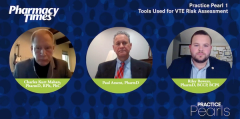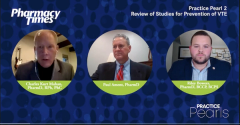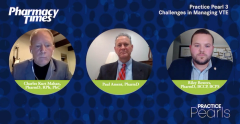
Practice Pearl 2: Review Guidelines for the Prevention of VTE
Episodes in this series

Paul Ament, PharmD, reviews the guidelines for the prevention of VTE.
Charles Kurt Mahan, PharmD, RPh, PhC: Let’s have a short review of some of the guidelines addressing prevention of venous thromboembolism [VTE] to start and what is suggested or recommended.
Paul Ament, PharmD: Overall, it is important to appreciate that being hospitalized increases your risk of developing a thromboembolic complication 8-fold. When you look at some numbers, it is estimated that anywhere around 8% of medical patients will develop a clot without anticoagulation. For patients who have had a stroke, the risk is very high: It is over 50% if we’re not using thromboprophylaxis.
The guidelines from the American College of Chest Physicians were last published in 2012, and some have thought of this as the bible of anticoagulation. This is before we had any of the direct oral anticoagulants FDA approved for prophylaxis. The American Society of Hematology then put out guidelines in 2018. Their recommendations are pretty similar. At this point, they have not advocated using the direct oral anticoagulants. They more strongly recommend the use of unfractionated heparin or low molecular weight heparin in the acutely ill patients. They prefer low molecular weight heparin probably because it is once-daily dosing instead of every 12 or 8 hours.
In the patient who is critically ill or the patient in the ICU [intensive care unit], low molecular weight heparin is once again favored because of the once-daily dosing and lower likelihood of developing HIT [heparin-induced thrombocytopenia] and some of the platelet abnormalities that we may see with unfractionated heparin. These guidelines then go in and talk about extended prophylaxis. What is surprising is that, despite some very strong data and with Dr Mahan’s data published in 2013, these guidelines still have not advocated continuing prophylaxis beyond the hospital discharge, despite having 2 FDA-approved products, 1 being betrixaban and the other being rivaroxaban.
Charles Kurt Mahan, PharmD, RPh, PhC: That’s a great point. The MARINER study came out after some of those guidelines were already published, first of all. Second, the availability and FDA approvals for both betrixaban and rivaroxaban came out after those guidelines. In and of itself, that highlights the FDA and the CDC [Centers for Disease Control and Prevention] focus on VTE with all these cases of VTE still occurring and it being highly preventable. There is still an unmet medical need, and that’s the reason they are approving the agents.
Newsletter
Stay informed on drug updates, treatment guidelines, and pharmacy practice trends—subscribe to Pharmacy Times for weekly clinical insights.




























































































































































































































